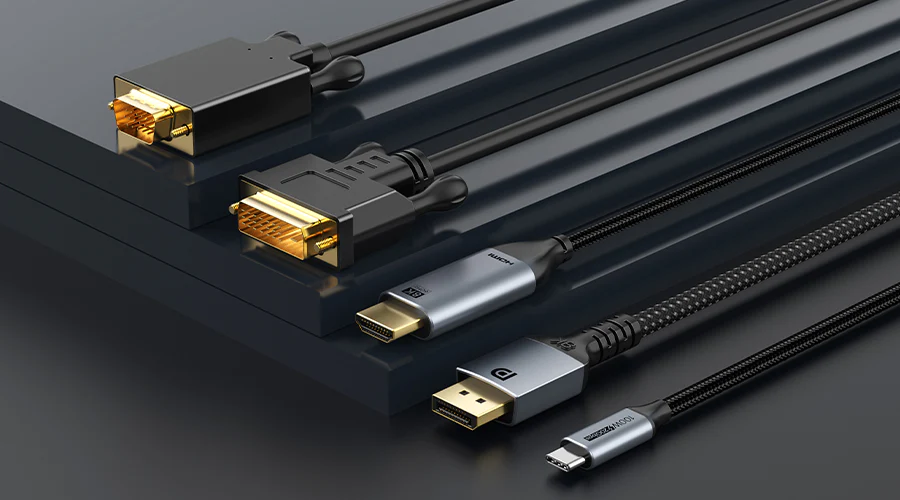In the ever-evolving world of technology, choosing the right connector for your devices can be a daunting task. With so many options available, from VGA to Displayport to HDMI to USB C, how do you know which one is right for you? In this blog post, we will break down the differences between each type of connector and help you make an informed decision on which one suits your needs best. Stay tuned to find out which connector reigns supreme in the battle of VGA vs Displayport vs HDMI vs USB C!
Introduction to Connectors: What are they and why do we need them?
In today’s digital world, the use of electronic devices has become an essential part of our daily lives. From smartphones to laptops, televisions to gaming consoles, these devices have simplified our lives in many ways. But have you ever wondered how these devices can connect and transfer data? The answer lies in connectors.
Connectors are physical interfaces that allow two electronic devices to communicate with each other by transmitting data or power signals. They come in various shapes and sizes depending on the type of device and its purpose. With advancements in technology, the number of connectors has also increased, making it challenging to choose the right one for your needs.
So why do we need connectors? The primary function of a connector is to establish a reliable connection between two electronic devices. It acts as a bridge that enables information or energy exchange between different systems. Without connectors, it would be impossible for us to connect our laptops to external monitors or charge our smartphones using a USB cable.
Moreover, connectors provide convenience and flexibility by allowing us to connect multiple devices without any hassle. For instance, imagine having different ports on your laptop for every external device you want to connect – it would be inconvenient and impractical. Connectors solve this problem by providing a universal interface that can be used for multiple purposes.
Overview of VGA, Displayport, HDMI, and USB C connectors
When it comes to connecting devices such as laptops, monitors, or TVs, the type of connector used can make a big difference in terms of picture quality, resolution, and compatibility. The four most commonly used connectors for video transmission are VGA (Video Graphics Array), Displayport, HDMI (High Definition Multimedia Interface), and USB C.
VGA was one of the first widely adopted video connectors and has been around since the late 1980s. It uses an analogue signal to transmit video data from a source device to a display. This means that it is limited in terms of image quality and resolution compared to its digital counterparts. VGA is capable of supporting resolutions up to 1920×1080 pixels at a 60Hz refresh rate. However, with the rise of high-definition displays and content, VGA has become outdated and is slowly being phased out.
Displayport was introduced in 2006 as an improvement over VGA Connector. It is a digital interface that allows for higher resolutions and better picture quality compared to VGA. Displayport also supports audio transmission along with video signals without the need for separate cables. It has gone through multiple versions over the years with each new version increasing its capabilities. The current version, Displayport 1.4 can support resolutions up to 8K at a refresh rate of 60Hz.
HDMI is another popular digital interface that was first introduced in 2002. Similar to Displayport, it carries both audio and video signals over a single cable without any loss in quality due to compression or conversion processes. HDMI has undergone several iterations with each new version increasing its bandwidth capabilities allowing for higher resolutions and better color depth support. The latest iteration – HDMI 2.1 can handle resolutions up to 10K at a refresh rate of 120Hz making it ideal for gaming or watching high-quality content.
USB C is the newest and most versatile connector on this list. It was first introduced in 2015 and has since become a standard for many devices, including smartphones, laptops, and tablets. USB C is capable of handling data transfer, power delivery, and video transmission all through one cable. This makes it incredibly convenient for users who want to connect multiple devices without the need for different cables or adapters. USB C can support resolutions up to 8K at a refresh rate of 60Hz.
Advantages and Disadvantages of each connector
When it comes to choosing the right connector for your devices, there are several options available in the market. Each connector has its own set of advantages and disadvantages, and it’s important to understand them before making a decision. In this section, we will discuss the pros and cons of each connector Displayport cable vs USB C VS hdmi VS thunderbolt.
VGA (Video Graphics Array) is one of the oldest connectors still in use today. It was first introduced in 1987 and has been a standard for connecting monitors to computers ever since. One of the main advantages of VGA is its compatibility with almost all devices that have a display output. This makes it an ideal choice for older devices or when connecting multiple displays with different ports. Another advantage is its affordability – VGA cables are relatively inexpensive compared to other connectors. However, one major disadvantage of VGA is its limited resolution capabilities. It can only support resolutions up to 1920x1080p at 60Hz, which may not be sufficient for high-definition displays.
Displayport was introduced in 2006 by VESA (Video Electronics Standards Association) as a replacement for VGA and DVI connectors. One of the biggest advantages of Displayport is its high bandwidth capacity, which allows for higher resolutions and refresh rates than VGA or DVI. It also supports multi-stream transport technology, which means you can connect multiple displays using a single cable. Additionally, Displayport also supports audio transmission along with video signals without any loss in quality. However, Displayport cables tend to be more expensive than other connectors.
HDMI (High Definition Multimedia Interface) has become the go-to choice for most modern devices due to its widespread usage and availability. Like Displayport, HDMI also supports high-resolution displays with up to 4K resolution at a 60Hz refresh rate. It also carries both audio and video signals through a single cable without any loss in quality. Another advantage of HDMI is its compatibility with other devices such as gaming consoles, Blu-ray players, and streaming devices. However, HDMI cables are not ideal for long-distance connections and may require signal boosters for longer runs.
USB C (Universal Serial Bus Type-C) is the latest addition to the connector family and has gained popularity due to its versatility. It can be used for video output as well as data transfer and charging. USB C also supports high-resolution displays with up to 4K resolution at a 60Hz refresh rate. Its small size makes it convenient for use in portable devices such as laptops, tablets, and smartphones. However, one disadvantage of USB C is that it may not be compatible with older devices without an adapter or converter.
Each connector has its strengths and weaknesses. When choosing the right connector, consider your device’s compatibility, resolution requirements, budget, and future-proofing needs. With this knowledge of the advantages and disadvantages of each connector type, you can make an informed decision that best suits your needs.
Factors to consider when choosing a connector (e.g. compatibility, resolution, speed)
When it comes to choosing a connector, there are several factors that you need to consider. These factors can have a significant impact on your overall experience and the performance of your devices. In this section, we will discuss the key factors that you should keep in mind when selecting a connector.
1. Compatibility:
One of the most critical factors to consider when choosing a connector is compatibility. You need to ensure that the connector you choose is compatible with both your device and the display or peripheral you want to connect it to. For instance, if you have an older device that only has VGA ports, then choosing a newer HDMI or DisplayPort connector would not be compatible unless you use an adapter.
2. Resolution:
The resolution refers to the number of pixels displayed on a screen. The higher the resolution, the clearer and more detailed the image will be. When selecting a connector, make sure it supports the maximum resolution of your display for optimal visual quality.
3. Speed:
Speed is another crucial factor to keep in mind when choosing a connector. This factor determines how fast data can be transmitted between devices through the cable. If you are transferring large files or streaming high-quality videos, then opting for a faster connection such as USB C or Thunderbolt would be ideal.
4. Length:
The length of the cable also plays an essential role in selecting a connector. It is recommended to choose cables with shorter lengths as longer ones can cause signal degradation and affect audio and video quality.
5. Match Your Device’s Capabilities:
It’s important to match up your device’s capabilities with those of the connectors available for them because some devices may not support certain resolutions or refresh rates that others do.
6. User-Friendliness:
Another factor worth considering is user-friendliness – how easy is it for you to set up and use? Some connectors require additional adapters or power sources while others offer plug-and-play functionality. Consider what works best for you and your devices.
7. Intended Use:
It is essential to consider the intended use of the connector when making your decision. If you are primarily using it for basic office work, a lower-resolution cable such as VGA may suffice. However, if you are a gamer or require high-quality visuals for graphic design work, then opting for HDMI or DisplayPort would be a better choice.
Future trends in connector technology
As technology continues to advance, the world of connectors is also evolving at a rapid pace. In this section, we will explore the future trends in connector technology and how they may impact the choices between VGA, DisplayPort, HDMI, and USB C.
1. Increasing demand for higher bandwidth: With the increasing popularity of high-resolution displays and data-intensive applications, there is a growing need for connectors that can support higher bandwidth. This trend is expected to continue in the future with advancements in display technology such as 8K resolution and virtual reality experiences. As a result, we can expect to see connectors with even higher data transfer rates being developed.
2. Shift towards reversible designs: A common annoyance with traditional connectors like VGA and HDMI is that they have a specific orientation for insertion, which can be inconvenient at times. To address this issue, newer connectors like USB C are designed to be reversible – meaning they can be inserted either way without any hassle. This trend towards more user-friendly and intuitive designs is likely to continue in the future.
3. Integration of power delivery: Another emerging trend in connector technology is the integration of power delivery capabilities into connectors themselves. For example, USB C already has this feature where it can not only transfer data but also deliver power up to 100 watts – making it possible to charge laptops and other devices through a single cable connection.
4. Wireless connectivity options: With advancements in wireless technologies such as Bluetooth and Wi-Fi, we may see a shift towards wireless connectivity options for devices that traditionally require physical connections through cables or ports. This could potentially eliminate the need for multiple cable types.
5. Smaller form factors: As devices become smaller and slimmer, there will be an increased demand for smaller form factor connectors that take up less space on devices while still providing high-speed data transfer capabilities. We have already seen this trend with miniaturized versions of HDMI (mini-HDMI) and USB (micro-USB), and we can expect to see more compact connector options in the future.



